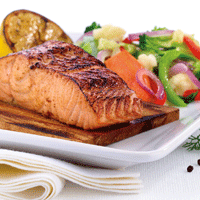After 14 years of running award-winning full-service Caribbean restaurants, Liz da Mata prides herself on staying ahead of the curve. Like many of her customers, she’s a mother who tries to make healthy food choices for herself and her family. So when the B.C. government launched its voluntary Informed Dining program last year, the owner of The Reef — with two locations in Vancouver and one in Victoria — jumped on board.
“Going through every single component of every item on our fairly large menu was an epic undertaking, especially since one plate can be made up of six or seven recipes,” says da Mata, who grew up in Winnipeg restaurants. “It took my executive chef and me three months from start to finish, but I’m happy we did it.” She’s also happy the province picked up the tab for lab analysis, which would have cost thousands.
It’s clear the foodservice industry can no longer ignore the consumer’s call for more transparency on the menu. Chicago-based Technomic Inc.’s “Canadian Healthy Eating Consumer Trend Report,” found 67 per cent of Canadians say it’s important to eat healthy and pay attention to nutrition, compared to just 54 per cent of consumers polled in 2010. Even if they would never order a quinoa salad, 35 per cent of consumers told Technomic they’re more likely to visit restaurants that offer healthy options. But, that thought process doesn’t necessarily extend to all restaurant occasions, as only 29 per cent of those polled said they consider health or nutrition when dining away from home, occasions for which consumers still tend to indulge and treat themselves.
But, Toronto dietitian Katie Jessop, foodservice business development manager for the Heart and Stroke Foundation’s Health Check program, which highlights healthy items on restaurant menus, says consumers are begging for nutrition information. “We know that more than 70 per cent of Canadians want it,” says Jessop, referencing information from the NPD Group and Harris/Decima polling research.
And, while a decision on whether or not to legislate nutritional information on menus across the country remains an ongoing discussion, many restaurateurs worry about a decrease in sales if they disclose nutrition information. But, Jessop says studies from the U.S., where disclosure is mandatory, show this hasn’t happened. “What they’ve seen is that the overall sales mix changes,” she says. “Consumers will be looking at two items, one with lower fat, sodium and calories, and they’ll go with that one.”
So, what does healthy mean? Depends on who you talk to. “When I ask a regular consumer what’s healthy, they could say local, organic, additive-free, low-gluten, no gluten or vegan,” Jessop says. “Restaurants say they can’t do all of that, so which ones are they going to choose?”
According to the aforementioned Technomic report, vegetarian and gluten-free claims are the hottest trends in healthy eating. While vegetarian claims increased more than 20 per cent on the research company’s list of top 250 limited-service restaurant (LSR, 24 per cent) and full-service restaurant (FSR, 22 per cent) menus between 2010 and 2012, gluten-free claims have more than quadrupled at LSRs and tripled at FSRs.
And, although the number of people with celiac disease who can’t tolerate gluten — a protein found in wheat, rye and barley — is small, people have been switching to a gluten-free diet after reading the 2011 bestseller Wheat Belly. They see it as a way to lose weight, boost energy and feel healthier, despite contrasting views about the validity of such claims.
“If you don’t offer gluten-free items these days, you’re not listening to your customers,” says da Mata, who now thickens The Reef’s famous jerk sauce with arrowroot and tapioca. “It’s been a huge phenomenon here on the west coast in the last couple of years, perhaps because of the book. It came on so quickly, it was crazy,” which suggests most people who ask for gluten-free products don’t have celiac disease.
Yet offering gluten-free items means much more than simply substituting corn or rice noodles for wheat pasta. Just ask Michael Gray, director of Culinary and executive chef at Boston Pizza, based in Richmond, B.C., which got its knuckles rapped by the Canadian Food Inspection Agency (CFIA) after unveiling its new gluten-free menu a year ago.
Though the chain’s corn-based gluten-free pasta and personal gluten-free pizza crust ($8.95) are manufactured and frozen at a separate facility, the fact that they’re cooked in a kitchen where fresh dough is being made puts celiac customers at risk, inspectors said.
After discussions with the CFIA, Boston Pizza re-launched its menu nationally in September under the trademarked name GlutenWise, with plans to expand it further. “We tell guests we can’t always guarantee there won’t be the slightest trace of gluten,” Gray adds, “but we go through every step possible to ensure it’s gluten-free.”
Casey’s Grill Bar, with locations in Ontario and Quebec, introduced its first gluten-free menu in Ottawa in 2010 with input from a staff member whose husband had celiac disease. “It’s a relatively small proportion of our total sales, but it is growing,” says executive chef Niels Kjeldsen, who now offers 20 gluten-free items.
To keep customers safe, Casey’s staff undergoes rigorous training, Kjeldsen says. Cooks use separate frying pans, cook gluten-free pasta in separate pots and deep fry it in a dedicated fryer.
Whether they’re gluten-intolerant or not, diners tend to choose lighter items on the special menu, such as the $16.99 Cedar Plank Salmon with the choice of a side (minus ponzu marinade and rice pilaf), and the $11.99 Rotisserie Chicken Breast (minus dipping sauce). Salads are also popular, with a choice of four to five gluten-free dressings. “It makes us a restaurant of choice if there’s one person in a family with a problem,” says Kjeldsen.
Even QSR chains are expanding their healthy offerings, particularly snacks. McDonald’s Canada offers real-fruit smoothies, and it has lowered calories and upped protein and calcium in its Happy Meals with apple slices and low-fat yogurt and milk. Low-sodium alternatives at McDonald’s and KFC also keep the chains ahead of proposed government regulations.
Despite the pages of nutrition analysis (estimated at $800 per recipe) and R&D to reduce sodium on the supply side, chefs are the first to admit these changes aren’t altering the eating habits of Canadians who see eating out as a treat. “We have a ton of healthy eating choices on the menu at Boston Pizza, but we don’t sell an awful lot of it,” says Gray, who’s reduced sodium on 75 per cent of the chain’s menu. “Somebody looking for a light lunch can have our multi-grain Chicken Stromboli ($11.79), but if you’re part of a hockey team or soccer team coming in after a game with your friends, you’re probably going to default with a few pounds of wings.”
Restaurants designed for a health-conscious crowd are having better luck. At The Greenhouse, a quick-service gourmet salad bar in Edmonton, co-owner Amilcar Prime says his customers ask three questions: is it gluten-free, does it contain dairy, and is the stock vegetable-based?
In 2009, when Prime saw the growing need for healthy items on the go, he convinced his chef brother, Mikhail, to leave fine-dining and join him. The business has grown steadily, and the brothers plan to open a second location downtown in July and expand their recipe analysis to provide more information. “We are changing the way people look at healthy food,” says Amilcar. “In the past, if it was good for you it usually didn’t taste great. Our philosophy on food is that it should be 80-per-cent healthy and 20-per-cent naughty.” His bestseller is the You Jerk! Chicken Salad with spinach and a homemade coconut-lime vinaigrette. It comes in two sizes, $10 (404 calories) and $14 (691 calories). The warm Brazilian Salad with Tofu is also popular with its sautéed vegetables and spicy tomato vinaigrette, fontina cheese and almonds ($10/$13.50; 377/637 calories).
Mikhail Prime says creating lighter food was the hardest thing he’s ever done as a classically trained chef. “I had to revise some dressing recipes 16 times before the dietitian was happy with the calorie count,” he says.
For now, high-end restaurants remain exempt from dining-by-number proposals since their menu changes so often, but that doesn’t mean they’re ignoring the healthy-food trend. At Toronto’s Nota Bene, where lunch brings office workers looking for lighter fare, chef David Lee captures the health trends in a $29 three-course NB Express menu. There’s dairy-free cauliflower soup with corn nuts, chipotle and kale chips, finished with a little olive oil. In the NB salad bowl, a gluten-free flax and chia-seed crunch and seasonal vegetables accompany an organic salmon fillet. Lee is also experimenting with the cheesy, nutty taste of nutritional yeast, beloved by vegans.
Meanwhile, back at The Reef, health-conscious diners can now peruse an in-house brochure showing 13 nutrients for each menu item, from Vitamin A to saturated fat. Will they choose the pan-seared Maracas Mahi Mahi with its new Health Check symbol ($20), slimmed down to 520 calories, 16 grams of fat and 790 mg sodium or the St. Bart’s Lamb Shank braised in coconut curry ($20) with 1,310 calories, 89 grams of fat and 1,340 mg sodium? “Customers may not always make the healthy choice,” says da Mata, “but they like to know they can make one if they want.”
Keep Reading
Technomic Updates Consumer Trends for Pork and Beef




















